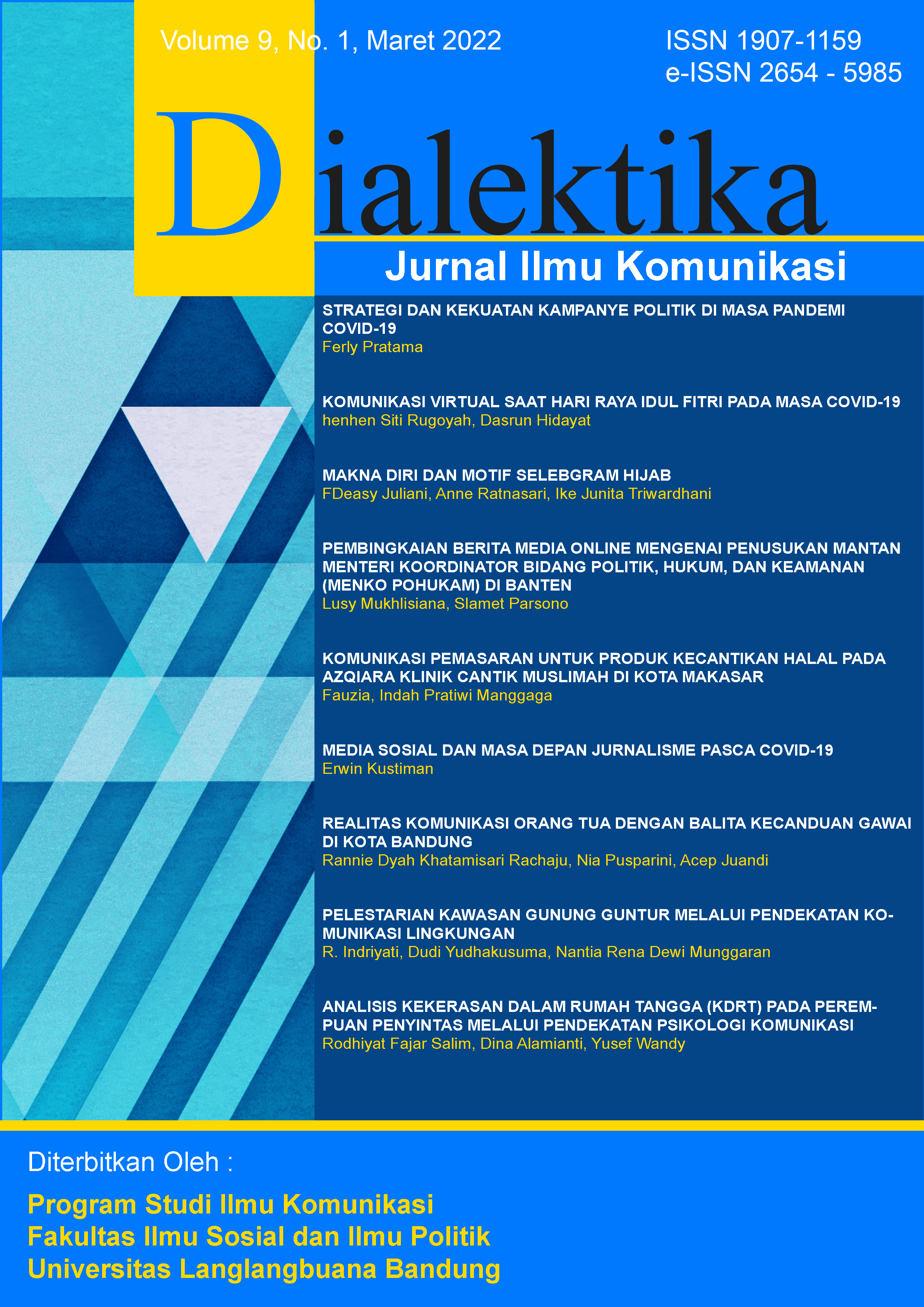Media Sosial dan Masa Depan Jurnalisme Pasca Covid-19
Abstract
Era Pandemi Covid-19 tak hanya mendisrupsi tatanan kehidupan sosial. Pada dimensi komunikasi, pandemi justru juga mengembangbiakkan “virus” lain yang dalam pandangan Organisasi Kesehatan Dunia (WHO) lebih berbahaya dibandingkan Virus Corona itu sendiri, yakni merebaknya kabar palsu atau hoaks melalui berbagai platform media sosial. Ironisnya, hal ini juga menggejala di ranah jurnalisme. Bagaimana masa depan jurnalisme akan sangat ditentukan oleh komitmen menjalankan prinsip etika dalam praktik jurnalistik. Artikel ditulis dengan pendekatan deskriptif dengan melakukan studi dokumentasi dan pustaka. Di masa mendatang, etika jurnalistik tetap memiliki posisi penting terutama untuk membedakan karya jurnalistuik dan konten media sosial secara umum.
References
Beckett, C., & Mansell, R. (2008). Crossing boundaries: New media and networked journalism. ICA Communication, Culture & Critique 2008. Retrieved from http://eprints.lse.ac.uk/4221
Bednarek, M., & Caple, H. (2014). Why do news values matter? Towards a new methodological framework for analysing news discourse in Critical Discourse Analysis and beyond. Discourse & Society, 135-158.
Berger, J., & Milkman, K. (2012). What Makes Online Content Viral? Journal of Marketing Research, 192-205.
Boczkowski, P.J. (2004). Digitizing the news: Innovation in online newspapers. The MITPress, Cambridge.
Wilkinson. Jeffrey , Grant. E, Fisher. Douglas J., Principles of Convergent Journalism: Oxford University Press, 2009
Quinn. Stephen, Lamble. Stephen, Online Newsgathering: Research and Reporting for Journalism; Taylor & Francis, 2008.
M. Briggs, Journalism 2.0: How to survive and thrive: A digital literacy guide for the information age, J-Lab: University of Maryland, 2007
C.Shirky, Here Comes Everybody: The Power of Organizing without Organizations, The Penguin Press, New York, 2008.
Klinenberg, E. (January, 2005). Convergence: News production in a digital age. The annals of the American Academy (597).
Kovach, Bill & Rosenstiel, Tom. The Elements of Journalism. 2001. Guardian Books 2003.
Krebs, I., & Lischka, J. (2019). Is audience engagement worth the buzz? The value of audience engagement, comment reading, and content for online news brands. Journalism, 714-732.
Lawrence Erlbaum. Jensen, Anders Bille: 2013. Journal of Business Models, Vol. 1, No.1 pp. 61-84.
R. Kim, “Apple stock dives on false report”, SFgate.com, October 2008
“2009, the year of Twitter and Facebook”, Agence France Presse, 15 December 2009
A.Jennifer, “Journalism in The Age of Social Media”, Reuters Institute Fellowship Paper University of Oxford, 2010
N.Nic, The rise of social media and its impact on mainstream journalism: A study of how newspapers and broadcasters in the UK and US are responding to a wave of participatory social media, September 2009
BBC Annual Report and Accounts 2008-09
K. Dharmasaputra, Jurnalisme Online, Asal Seru dan Saru, 2010.
Priyambodo RH, Melek Multimedia Massa, 2010.
Jenkins Henry, Convergence Culture: Where Old and New Media Collide, 2006.
Kaplan & Haenlein, Users of the world, unite! The challenges and opportunities of Social Media, 2012.
I. Haryanto, Jurnalisme dan Media Sosial, Kompas, Sabtu, 24 September 2011.
P. Robert G., Journalists’ Perceptions of the Future of Journalistic Work, Mei 2015.
Taubenberger JK, Morens DM. 1918 influenza: the mother of all pandemics. Emerg Infect Dis. 2006;12(1):15–22.
De Garza, Alejandro. How Sosial Media is Shaping Our Fears of – and Response to – the Corona Virus (Majalah Time, 16 Maret 2020)
Hope dan Jones; The Impact of Religious Faith on Attitudes to Environmental Issues and Carbon Capture and Storage (CCS) Technologies: A Mixed Methods Study (2014)
Copyright (c) 2022 Dialektika

This work is licensed under a Creative Commons Attribution-NonCommercial-ShareAlike 4.0 International License.





